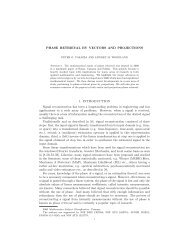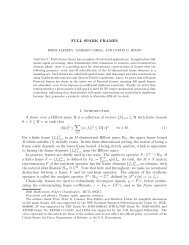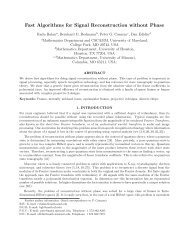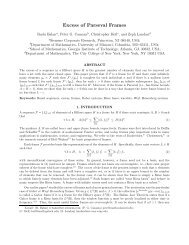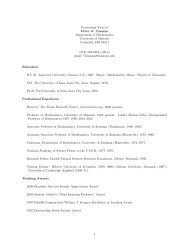Introduction to Finite Frame Theory - Frame Research Center
Introduction to Finite Frame Theory - Frame Research Center
Introduction to Finite Frame Theory - Frame Research Center
You also want an ePaper? Increase the reach of your titles
YUMPU automatically turns print PDFs into web optimized ePapers that Google loves.
<strong>Introduction</strong> <strong>to</strong> <strong>Finite</strong> <strong>Frame</strong> <strong>Theory</strong> 31<br />
The advantage of the conjugate gradient method, which we will present next, is<br />
the fact that it does not require knowledge of the frame bounds. However, as before,<br />
the rate of convergence certainly does depend on them.<br />
Proposition 20 (Conjugate Gradient Method, [97]). Let (ϕ i ) M i=1 be a frame for<br />
H N with frame opera<strong>to</strong>r S. Given a signal x ∈ H N , define three sequences (y j ) ∞ j=0 ,<br />
(r j ) ∞ j=0 , and (p j) ∞ j=−1 in H N and corresponding scalars (λ j ) ∞ j=−1 by<br />
and for j ≥ 0, set<br />
and<br />
y 0 = 0, r 0 = p 0 = Sx, and p −1 = 0,<br />
λ j = 〈r j, p j 〉<br />
〈p j ,Sp j 〉 , y j+1 = y j + λ j p j , r j+1 = r j − λ j Sp j ,<br />
p j+1 = Sp j − 〈Sp j,Sp j 〉<br />
〈p j ,Sp j 〉 p j − 〈Sp j,Sp j−1 〉<br />
〈p j−1 ,Sp j−1 〉 p j−1.<br />
Then (y j ) ∞ j=0 converges <strong>to</strong> x in H N and the rate of convergence is<br />
|||x − y j ||| ≤<br />
2σ j<br />
1 + σ 2 j |||x||| with σ = √<br />
B −<br />
√<br />
A<br />
√<br />
B +<br />
√<br />
A<br />
,<br />
and ||| · ||| is the norm on H N given by |||x||| = 〈x,Sx〉 1/2 = ‖S 1/2 x‖, x ∈ H N .<br />
6 Construction of <strong>Frame</strong>s<br />
As diverse as the various desiderata are which applications require a frame <strong>to</strong> satisfy,<br />
as diverse are also the methods <strong>to</strong> construct frames [37, 59]. In this section,<br />
we will present a prominent selection. For further details and results, such as, for<br />
example, the construction of frames through spectral tetris [31, 47, 44] and through<br />
eigensteps [30], we refer <strong>to</strong> Chapter [155].<br />
6.1 Tight and Parseval <strong>Frame</strong>s<br />
Tight frames are particularly desirable due <strong>to</strong> the fact that the reconstruction of<br />
a signal from tight frame coefficients is numerically optimally stable as already<br />
discussed in Section 5. Most of the constructions we will present utilize a given<br />
frame, which is then modified <strong>to</strong> become a tight frame.<br />
We start with the most basic result for generating a Parseval frame which is the<br />
application of S −1/2 , S being the frame opera<strong>to</strong>r.



